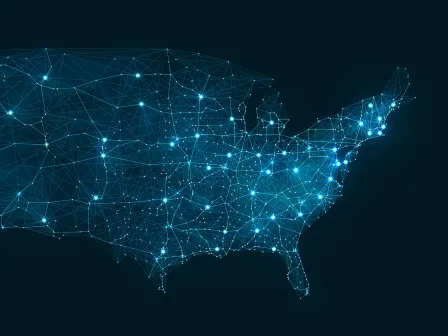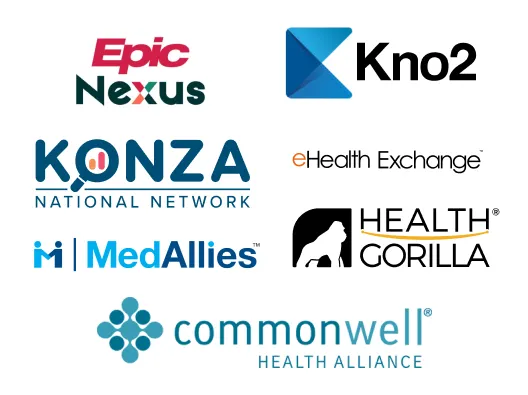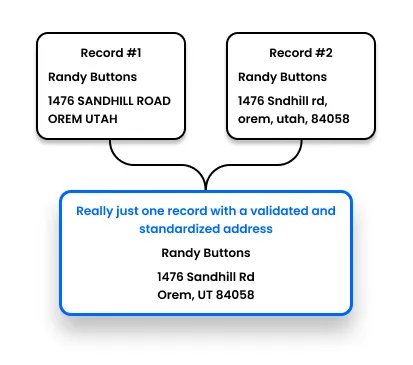What are qualified health information networks (QHIN)?

Qualified health information networks (QHIN) are digital spaces where health information is securely shared between various health entities, such as hospitals, pharmacies, practitioners, etc.
Unlike regular health information networks (HINs), QHINs are recognized by the Office of the National Coordinator for Health Information Technology (ONC) nationwide, which is critical in advancing nationwide health interoperability.
Here at Smarty, we deal with address data, one of the most important pieces of healthcare information. It's how medications, bills, and home treatments reach the right patient. Maybe you'd like to test drive some of the healthcare-related address standardization and verification tools we offer. Feel free to click those links, then keep on reading more about QHIN below.
| Get FREE US@ Sample Lookups | Read About Project US@ | Read Even More About Project US@ |
|---|---|---|
We don't need a copay for you to learn more. Here's an outline just for you:
- Introduction to qualified health information networks (QHIN)
- What are health information exchanges (HIEs)?
- HIN vs. HIE vs. QHIN - Understanding the differences
- Understanding nationwide interoperability and QHINs role
- Smarty and Project US@ address standardization and formatting
- Conclusion
Introduction to qualified health information networks (QHIN)
As we mentioned earlier, qualified health information networks (QHINs) are just a little more special than regular HINs. To be recognized with that very important letter Q, a healthcare organization must meet stringent requirements under TEFCA guidelines in the USA related to privacy, governance, interoperability, and security. As of 2024, there are 7 QHINs in the United States:

CommonWell Health Alliance and Kno2 were recently added to the qualified categories! Good job, guys! TEFCA would be so proud.
Wait, wait, wait… What is TEFCA?
The Trusted Exchange Framework and Common Agreement (or TEFCA) outlines the common principles for data exchange within healthcare systems and institutions.
Organizations must securely transfer health records and personally identifiable information (PII) to comply with HIPAA (the Health Insurance Portability and Accountability Act). QHINs allow healthcare providers to do just that by following the technical requirements and rules set out by TEFCA. They facilitate seamless digital transportation of medical records across health information exchanges to improve patient care.
The entire onboarding process is carefully monitored by the RCE (the recognized coordinating entity) that's designated by the Office of the National Coordinator (ONC). They also continuously oversee QHINs and ensure compliance with TEFCA standards. (With so many acronyms, we feel like we're swimming in alphabet soup.)
Don't worry. The short version is that there are a lot of people watching to make sure that digitally transferred medical records are safe. PHEW!
What are health information exchanges (HIEs)?
A health information exchange (HIE) is a digital platform where patient and health-related information is passed between various institutions. This saves offices time and space when trying to keep healthcare records up to date between test results, medication dosage shifts, changes of therapy, and any other number of related health processes.
Get those tacky filing cabinets and folders outta here!
The types of institutions involved in the exchange of digital healthcare information are:

- Clinicians
- Laboratories
- Hospitals
- Pharmacies
- Health Plans
- Providers
- And patients
Several different types of transfers can be performed using an HIE, namely a direct exchange (the ability to transfer information securely between healthcare providers to enhance coordinated care), a query-based exchange (the ability for healthcare providers to find or request information on a patient from other providers), and consumer mediated exchange (the ability for patients to collect and control the use of their health information amongst healthcare providers).
HIN vs. HIE vs. QHIN - Understanding the differences
Your brain is now fully swimming in alphabet soup. Let's put some structure to these letters by describing how they relate to each other.
HIN = Health information network. HINs can connect to other HIEs and HINs but set their own rules.
HIE = Health information exchange. HIEs can connect to other HIEs and HINs but set their own rules. They're more specifically used to improve patient outcomes and ease the exchange process.
QHIN = Qualified health information network. QHINs can only connect to other QHINs that follow the same stringent security guidelines in support of the most secure form of healthcare exchange for the purpose of improving patient outcomes.
Understanding nationwide interoperability and QHINs role
Understanding a QHIN and the players in that game will help us learn more about the problems they solve in the healthcare industry, specifically for advancements in nationwide health interoperability in the US.
Using a QHIN poses several benefits. Enhanced national interoperability, efficient healthcare data exchange, heightened patient security, and more comprehensive insights. Several use cases for nationwide QHIN interoperability exist, but these main ones are especially interesting to consider:
Patient access to their own health information: Patients are able to access their health data from multiple providers across the country. Think of cancer patients seeing multiple specialists across the nation, patients working with revision surgeons, or patients attempting to provide proof of a clean bill of health for out-of-country service or work opportunities. Rather than waiting for a general practitioner or hospital to make time to fax a paper trail to the correct party physically, a patient has complete control over where their information is sent and when.
Care coordination: As seamless as the patient experience is with record tracking and sharing, consider doctors who are all working with the same patient. A QHIN empowers healthcare providers (with the patient's consent, of course) to more easily and accurately access and share a patient's full health history for more informed treatment plans, reduced duplication of tests and procedures, and a more direct flow of care.
Public health reporting: Can anyone say COVID-19? Too soon? Well, QHINs also help with pandemics or outbreaks, assisting public health agencies or federal agencies in gathering accurate information across the country to track the spread of diseases. This informs local healthcare providers on the most efficient way to intervene and respond to crises.
These use cases are important for health systems for seamless sharing, but there are additional reasons to use QHINs over just a regular HIE. Qualified health information networks also help to eliminate incorrect patient matching and duplicate patient information. Because QHIN's technical framework is highly intelligent, it requires structuring to match. QHINs rely on standardized APIs (application programming interfaces) to allow electronic health records (EHR) systems to communicate with each other more easily.
Smarty and Project US@ address standardization and formatting
The lack of unified address standardization in healthcare makes aggregating and sharing that data in QHINs next to impossible without encountering errors. One of the requirements for becoming a qualified network is that the information is standardized in Project US@ (pronounced Project USA) formatting. Some of the technical requirements Project US@ ensures for its data are:
- All letters are capitalized
- Certain words are not allowed to be shortened ("HIGHWAY" will always be written out and never abbreviated to "hwy" when using Project US@'s formatting)
For a more comprehensive list of the ways that Project US@ helps to create standardized healthcare records, you can read Smarty's article on what Project US@ is and why it matters, the Project US@ technical specifications, or the Project US@ AHIMA Companion Guide.
Here at Smarty, we're passionate about (and even obsessed with) clean, standardized, and validated addresses. Our tools implement Project US@ directly into your systems, bringing you one step closer to becoming QHIN certified.
Conclusion
QHINs are transforming healthcare by enabling seamless TEFCA exchanges across the country. Ensuring a secure exchange of health information between providers, federal agencies, and other entities, QHINs contribute to improved patient outcomes and more efficient care coordination. With the help of standardized formats like Project US@, healthcare organizations keep address data clean, accurate, and interoperable—critical factors in achieving QHIN certification.
As nationwide exchange purposes expand, platforms like Smarty's address standardization tools are crucial in simplifying the journey toward greater interoperability and data accuracy. Talk to an address intelligence expert today to see how using tools backed by the power of Project US@ can benefit your organizations today!